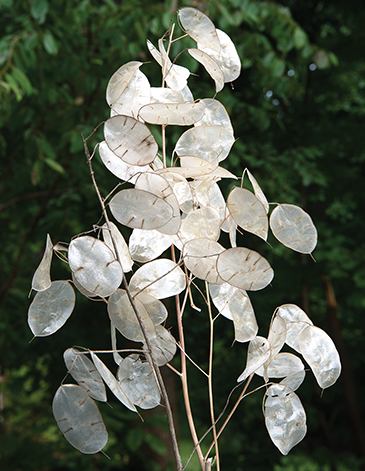Want to be an enriched gardener in 2014? Well, how about cashing in with money plants?
Don’t start counting on any extra income though — lunaria, also known as the money plant, only makes round, parchment-like seed pods that have the shimmer of freshly minted silver coins.
Although it originates from the Balkans, money plant (Lunaria annua) has been an heirloom favorite in Southern gardens on this side of the Atlantic since it was introduced to the Colonies in the 1600s, with the seeds of this easy-to-grow plant being passed down through the generations.
Sown now, the seeds of this biennial will produce 2- to 3-foot plants next spring that will pop with clusters of small white or purple flowers floating above the foliage.
 But while the blooms are cute, and also attract butterflies, they are only an opening act to the main attraction. It is the round seed pods that add the most interest to the garden when their green coverings turn a dull brown, fall off and reveal the shiny inner ovals, which contain seeds for next year’s crop.
But while the blooms are cute, and also attract butterflies, they are only an opening act to the main attraction. It is the round seed pods that add the most interest to the garden when their green coverings turn a dull brown, fall off and reveal the shiny inner ovals, which contain seeds for next year’s crop.
When cleaned of their coverings and seeds, the delicate, shiny ovals are especially eye-catching in dried indoor flower arrangements.
Lunaria will grow almost anywhere, but for healthier, better producing plants, seed in a site that has well-worked, compost-enriched soil and gets at least four to five hours of sun each day, with some shade in the afternoon. And don’t worry about deer; money plant is not one of Bambi’s favorites.
After flowering but before the seed pods dry on their stems, common lunaria tends to disappear into the garden’s deep sea of jade. However, ‘Variegata’ and ‘Alba Variegata’ are snazzier versions that show off brightly dappled foliage quite capable of adding extra color to help break up the green, green landscape.
Keep in mind though that a happy stand of money plants can readily reseed to the point of being invasive if the pods mature and are not harvested yearly, so be sure to pick and pass along the seeds of this beauty to keep it from becoming a beast in your garden.
L.A. Jackson is the former editor of Carolina Gardener magazine. Want to ask L.A. a question about your garden? Contact him by email at: lajackson1@gmail.com.
 Timely Tip
Timely Tip
It is peony planting time! If you have been reluctant to grow peonies because of their alleged reputation to be finicky in flowering, try planting older varieties such as ‘Teresa’, ‘Sarah Bernhardt’, ‘Felix Crousse’ or ‘Festiva Maxima’ that require less cold for bud set, or ask your local nursery for newer peony selections specifically bred for mild Southern winters.
In addition, since these pretties need a good chill for proper bloom production, bury the crowns only about 1-1/2 inches below ground so they will be less insulated from the cold weather. Finally, for stronger, sooner flowering, only buy divisions that have at least three to four “eyes.”
To Do in the Garden
September
Before the first frosts cut them down to the ground, mark the locations of herbaceous perennials, so they won’t be accidentally dug up during next spring’s planting frenzy.
Rake around fruit trees to not only remove fallen leaves and dropped fruit but also to help break up the life cycles of destructive insects and disease-producing organisms that might overwinter in the leftover plant material.
If you have green tomatoes still on the vine as the first frosts approach, pick them off, wrap each individually in a half-sheet of newspaper and store in a cool, dry area. Check the tomatoes weekly, as they will slowly ripen in storage.
Migrating feathered fliers will appreciate it if you keep the bird feeder well stocked and the bird bath filled with fresh water.
Fresh grass clippings and fall leaves are the perfect one-two combination of ingredients for creating a compost pile.
October
Pansies, anyone? Now is the great time to plant these persistent wintry beauties. Adding a time-release fertilizer at planting time will increase their flower power during the cold months.
To help prevent black spot next year, rake up and discard the summer mulch and debris from under roses, and replace with a fresh winter mulch.
Your favorite hostas, cannas and daylilies can be dug up and divided now.
Any newly seeded lawns should be raked every few days to prevent falling leaves from covering and smothering the young grass seedlings.
Leaves should also be kept out of the water garden. An easy way to do this is to simply drape a fine mesh plastic screen over the pond and keep it in place until this year’s leaves have fallen.







